This blog is typically a place where I share musical resources and piano practice tips. I thought I would do something a little bit different in this post, and share with you a peek into our homeschool world.
This coming fall, I will be homeschooling my oldest daughter again for her 6th grade year. We take what is called an eclectic approach to homeschooling. This means we don’t follow one set philosophy such as Classical or Charlotte Mason. It also means we don’t use one boxed curriculum that overs every subject. Instead, I have picked out parts from different homeschooling resources that I believe best fit my daughter’s personality and interests.
My rising 6th grader’s main interests are science, reading and art/engineering, so you’ll see that reflected in both how we structure things and the materials we use for learning. She also learns best by hands-on activities.
Below is the quick version of what we’re using for 6th grade. For more detailed explanations, scroll on down!
Writing: Bible-Based Writing Lessons by the Institute for Excellence in Writing
Grammar: Grammar for the Well-Trained Mind
Literature: Individual book, short story, and poetry studies (listed in more detail below)
Math: Singapore Math Primary Mathematics 6A & 6B
Geography: Evan-Moor Skill Sharpeners Geography & Draw Mexico, Central & South America
Social Studies: A History of US books 6-10 by Joy Hakim
Latin: First Form Latin Set by Memoria Press
Music: Busy Kids Do Music History, Busy Kids Love Music podcast, piano lessons
Art: Art Class at a co-op and monthly classes at an art museum
Critical Thinking: The Basics of Critical Thinking by Michael Baker
STEM: Weekly Robotics class at a co-op (and additional activities listed below)
Typing: www.typing.com. (It’s free!)
Writing: Bible-Based Writing Lessons by the Institute for Excellence in Writing
For 5th grade, we completed the Institute for Excellence in Writing’s Teaching Writing: Structure and Style. The course we’re using this year 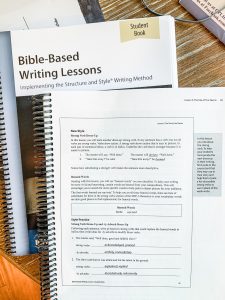 reviews all the models of structure and elements of style that were taught in that course, but using Bible passages and topics this time around. The thing appreciate most about this program is how well the tools that are learned can be implemented in so many other subjects. When my daughter is writing a paragraph for social studies, I might say to her, “Use your dress-ups!” and she’ll know exactly what that means.
reviews all the models of structure and elements of style that were taught in that course, but using Bible passages and topics this time around. The thing appreciate most about this program is how well the tools that are learned can be implemented in so many other subjects. When my daughter is writing a paragraph for social studies, I might say to her, “Use your dress-ups!” and she’ll know exactly what that means.
Grammar: Grammar for the Well-Trained Mind
This will be our first year in this series after graduating from the First Language Lessons series by the same author/publisher. Grammar is something my daughter struggled with when we first transitioned to 
homeschool, after not having it in public school since her early elementary years. The classical approach to grammar has really helped simplify things for her by memorizing rules and chants and repeating, repeating, repeating. This series takes ALL the prep work for a parent-teacher out of it. It lays out the script of every word that you’ll say during a lesson and divides the material into 4 short lessons each week for 36 weeks.
Literature: Individual book, short stories and poetry studies.
We do a read-aloud each night (using a list from Brave Writer) and have a super fun monthly mother-daughter book club with a couple of other homeschooling families.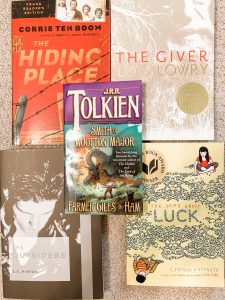
In addition to the book club, we include literature that we take more of a “deep dive” into as part of our curriculum. I usually find resources from TpT for these. We’ll be reading the following books this year:
The Hiding Place by Corrie Ten Boom
“Smith of Wootton Major” and “Farmer Giles of Ham” by J.R.R. Tolkien (short stories)
The Thing About Luck by Cynthia Kadohata
A poetry unit (largely using materials and suggestions from Match Fishtank)
Science: Young Explorer Series- Exploring Creation with Human Anatomy and Physiology & Anatomy Notebooking Journal for Exploring Creation with Human Anatomy and Physiology
I did not love science ever during my own educational experience, but I have to say that this has ended up being one of my favorite subjects to teach my daughter. I think that has a lot to do with the fantastic, in-depth science curricula that is out there — and I’m super excited for our upcoming year with this one!
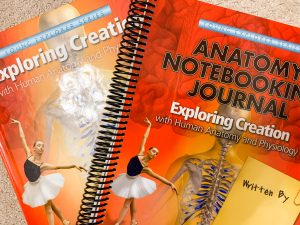 This textbook is conversational in tone, which makes it very approachable. It periodically asks a student to retell what they just read and learned. I find this helps my daughter think more deeply about how to communicate facts in her own words. There are loads of experiments and activities throughout.
This textbook is conversational in tone, which makes it very approachable. It periodically asks a student to retell what they just read and learned. I find this helps my daughter think more deeply about how to communicate facts in her own words. There are loads of experiments and activities throughout.
You MUST get the notebooking journal if you ever do an Apologia science program. It incudes a suggested schedule which breaks down the materials into 2 science lessons per week over 28 weeks. There is Scripture copywork, cut and fold miniature books, review questions and crossword puzzles, among other things. It really is a rich and in-depth approach to learning anatomy.
Math: Singapore Math Primary Mathematics 6A & 6B
We’re continuing with Singapore math this year, and I’m feeling much more confident in my understanding of how this program works! When we first started with the program, we just used the Home Instructor’s Guide, Textbook and Workbook. I found that the workbook problems were so simple I began to worry my daughter wasn’t being challenged enough.
I then learned about the Intensive Practice and Challenging Word Problems books for each level, and those have been a game changer! Adding these books to the mix has turned this into quite a rigorous math program and given my daughter lots of practice not simply at replicating a formula, but at really thinking mathematically.
Social Studies: The History of US Books 6-10 by Joy Hakim
These books are a treasure. History was my daughter’s least favorite subject when she attended public school, but she recently told me that she now finds it fascinating. I think so much of that is due to these beautiful books. We spent last year studying the United States’ history up until the Civil War and will be picking up with that in the fall.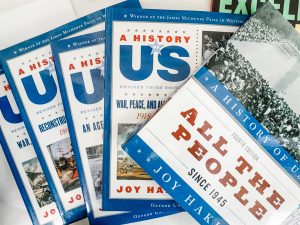
Hakim includes an abundance of pictures and maps, and so many stories and biographies from people you don’t always hear about in history. The books don’t include any type of teaching guide/materials, so I purchase the corresponding Teaching Guides from John Hopkins University. The Teaching Guides includes worksheets, review questions, vocabulary and a plethora of project ideas.
Geography: Evan-Moor Skill Sharpeners Geography
This is our second year using the Evan-Moor Skill Sharpeners series. These books are something my daughter works her way through mostly independently (so this is when I get a bit of my work done!). There are some hands-on projects that require my involvement. The pictures and  reading passages are engaging. I personally love the hands on projects because they’re very relevant. For example, this past year my daughter had to create an itinerary for riding a train through Europe. This year, she’ll do things such as create a slideshow of a place she learns about in one of the units and later plan a vacation and exchange money from one country to another using current exchange rates.
reading passages are engaging. I personally love the hands on projects because they’re very relevant. For example, this past year my daughter had to create an itinerary for riding a train through Europe. This year, she’ll do things such as create a slideshow of a place she learns about in one of the units and later plan a vacation and exchange money from one country to another using current exchange rates.
Geography: Draw Mexico, Central and South America
We used this same series last year to draw the USA. We will continue to use this series to work our way around the globe. I love how drawing the map helps my child to put geography into context. She learns to grasp connections, relative size and neighboring areas on a deeper level.
Music: Busy Kids Do Music History, Busy Kids Love Music podcast, piano lessons
You had to know I use my own products for music, right?! We made it 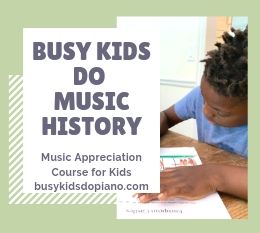 through Unit 6 (The Romantic Period) of my Busy Kids Do Music History course this year. We will pick up with music of the Modern Era in the fall. Listening to my podcast episodes as they are released has been a fun way to incorporate additional music appreciation when we’re running errands around town. My daughter is also working her way through Busy Kids Do Piano, and will continue to work through Level 3B during the summer months.
through Unit 6 (The Romantic Period) of my Busy Kids Do Music History course this year. We will pick up with music of the Modern Era in the fall. Listening to my podcast episodes as they are released has been a fun way to incorporate additional music appreciation when we’re running errands around town. My daughter is also working her way through Busy Kids Do Piano, and will continue to work through Level 3B during the summer months.
Latin: First Form Latin Set by Memoria Press
My husband is the Latin scholar of our house, so he teaches this subject to our daughter once a week. I provide support in between as she works through her assignments. If you don’t know Latin, Memoria Press has instructional DVDs for students to watch, as well as all kinds of additional supportive materials. I’ve found their program to be very well organized, and to complement well the sentence diagramming and other skills we learn in our grammar class.
Critical Thinking: The Basics of Critical Thinking by Michael Baker
I didn’t love the workbook we used in 5th grade, and I was delighted to find 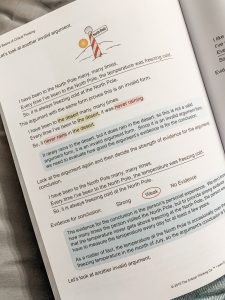 something more up our alley for the upcoming year. This book teaches critical thinking skills and concepts through a very organized, step-by-step process.
something more up our alley for the upcoming year. This book teaches critical thinking skills and concepts through a very organized, step-by-step process.
STEM: Weekly Robotics class at a co-op and additional materials listed below
STEM is rather informal at our house. I keep a few sets of activities for my daughter to work through independently, and ask that she pick a couple each week. Here are the activities that will be part of the rotation during 6th grade…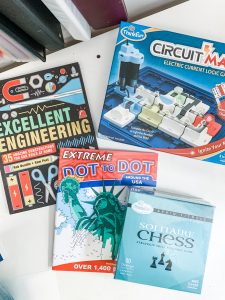
Excellent Engineering: 35 Amazing Constructions You Can Build at Home
Extreme Dot-to-Dot: Around the USA





Thank you for sharing this link, as it has made a significant impact on my homeschooling approach and has been a source of encouragement.